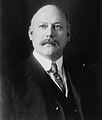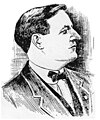1916 United States presidential election
Incumbent Democratic President Woodrow Wilson was narrowly re-elected, defeating former associate justice of the Supreme Court Charles Evans Hughes, the Republican candidate.
Hughes remains the only person to have served as a Supreme Court justice and later been a major party's presidential nominee.
[2] Despite their sympathy for the Allied forces, most American voters wanted to avoid involvement in the war and preferred to continue a policy of neutrality.
Wilson secured a narrow majority in the Electoral College by sweeping the Solid South and winning several swing states with razor-thin margins.
Hughes remains, as of today, the only serving Supreme Court justice to be nominated for president by a major political party.
For Vice President, Progressives nominated businessman John M. Parker of Louisiana, who had run an unsuccessful campaign.
California Governor Hiram Johnson was suggested for renomination, and Raymond Robins, chairman of the party convention, was proposed, but both withdrew their names in favor of Parker.
However, Roosevelt telegraphed the convention and declared that he could not accept their nomination and would be endorsing Republican nominee Charles Evans Hughes for the presidency.
He also believed Wilson was allowing Germany and other warring nations in Europe to "bully" and intimidate the United States.
[7][8][9] Former U.S. Representative Victor Murdock of Kansas pushed for a ticket consisting of William Jennings Bryan and Henry Ford but nothing came of it.
[citation needed] All those discussed refused to consider the notion, and by this point, some leaders such as Henry Justin Allen had started to follow Roosevelt's lead and endorsed Hughes.
Finally, when the Progressive Party National Committee met in Chicago on June 26, those in attendance begrudgingly endorsed Hughes; even those like Ickes who had vehemently refused to consider granting an endorsement to Hughes began to recognize that without Roosevelt the party had no electoral staying power.
Most members returned to the Republican Party, but a substantial minority supported Wilson for his efforts in keeping the United States out of World War I.
Colby, while opposed to the endorsement of Hughes, now considered a Progressive campaign impractical and privately supported Wilson.
[13] Debs, who had served as the party's presidential nominee since its foundation, chose to run for a seat in the United States House of Representatives from Indiana's 5th congressional district.
[14] Allan Benson, a newspaper editor from New York, quickly came to dominate the field on a platform of his fervent opposition to militarism and proposal that all wars should be voted upon in a national referendum.
Rather than a traditional nominating convention, the vote was conducted through a mail-order ballot, with Benson capturing 16,639 out of a total of 32,398 cast (to 12,264 for Maurer and 3,495 for Le Sueur).
It was generally recognized early on that Hanly's nomination was favored with a supporter of his, Robert Patton, being named as permanent chairman of the convention.
This culminated with the adoption of much of his program into the Party platform and his own nomination for the presidency, Hanly receiving 440 votes to Sulzer's 181.
[17][18] Ira Landrith, a Presbyterian minister from Tennessee and member of the Flying Squadron of America was nominated for the vice presidency after other names were withdrawn from contention before the first ballot.
[22] Hughes also attacked Wilson for his support of various "pro-labor" laws (such as limiting the workday to eight hours), on the grounds that they were harmful to business interests.
Hughes was helped by the vigorous support of popular former President Theodore Roosevelt, and by the fact that the Republicans were still the nation's majority party at the time.
[23][24] In the weeks prior to the election, Wilson began to worry that, were he to lose the race to Hughes, he would remain a lame duck until March 1917.
"[31][32] By Wednesday evening, Wilson had secured 254 electoral votes in the counting, needing either California or Minnesota to claim victory.
Wilson was the second of just four presidents in United States history to win re-election with a lower percentage of the electoral vote than in their prior elections, after James Madison in 1812, Franklin D. Roosevelt in 1940 and 1944 and Barack Obama in 2012.
Wilson's popular vote margin of 3.1 percent was the smallest attained by a victorious sitting president since 1812 and retained that status until 2004.
Wilson was the last Democrat to win an election without carrying Minnesota, Massachusetts, and Rhode Island (although he had previously won the latter two states in 1912).
Hughes managed to carry only 976 counties (32.30%), the smallest number in the Republican column in a two-party contest during the Fourth Party System.



































